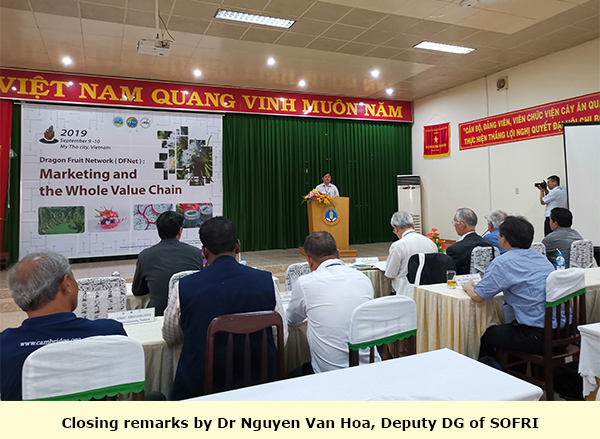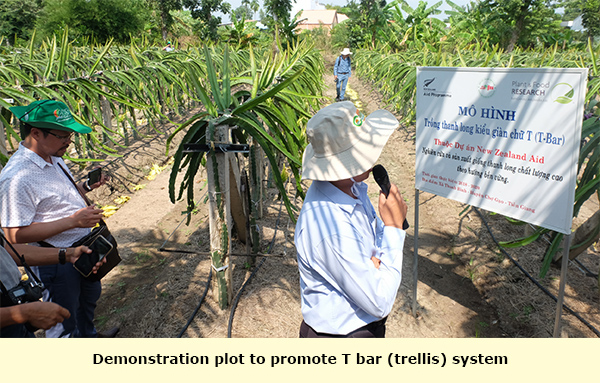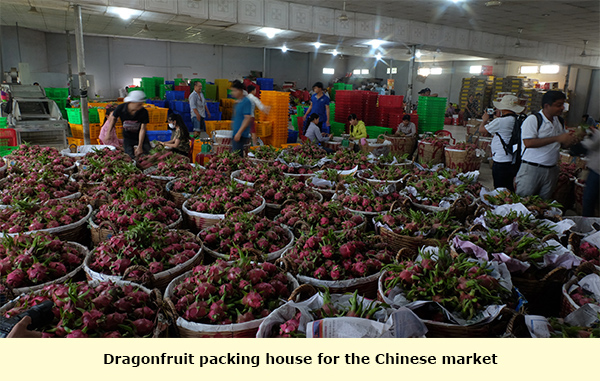Article based on DFNet’s workshop on Marketing and the Whole Value Chain for Dragon Fruit, 9-10 September, My Tho City, Vietnam.
Dragonfruit or pitaya (Hylocereus sp. and Selenicereus sp.) is gaining popularity with expanding global markets and increase in production areas as observed in Vietnam, China, India and some countries in Latin America. Adding to the diversity of mainstream tropical fruits already in the market, dragonfruit has been promoted as one which is exotic and possesses significant health benefits. For producers of the fruit, there are continuous efforts to grow cultivars which are high yielding and have acceptable tastes to boost consumer demand, besides having high productivity and profitability.

Vietnam is currently the biggest producer and exporter of dragonfruit with a total area of 55,000 ha. Other producers are Thailand, Taiwan, Philippines, Malaysia, Sri Lanka, Australia, Israel, while producers in South America include Mexico, Ecuador, Columbia, Nicaragua and Guatamala. Recent data have shown that China has embarked on large scale planting adding up to more than 60,000 hectares. Vietnam exports 80 – 85% of its production, mainly to China.
The biggest consumer is still China, with smaller amounts exported to other Asian countries, EU and US. With new players such as China embarking on large scale planting and India getting ready for the commercial growing of the ‘exotic superfruit’, the stage is set for dragonfruit to be developed as one of the fastest expanding tropical fruits besides banana, pineapple, avocado, mango and papaya.
The upbeat in global dragonfruit production and market is not without its constraints, the three most important ones being pests and diseases incidences, lack of good postharvest practices and suitable farm practices. This was discussed in a workshop jointly organised by DFNet (Dragonfruit Network) of Food and Fertilizer Technology Centre (FFTC) Taiwan, Vietnam Academy of Agricultural Sciences (VAAS) and Southern Horticulture Research Institute (SOFRI, Vietnam) in My Tho City, Vietnam from 9-10 September 2019. The workshop entitled ‘Dragonfruit Network: Marketing and the Whole Value Chain’ was attended by participants from Cambodia, India, Indonesia, Japan, Malaysia, New Zealand, Philippines, Taiwan, Thailand, USA and Vietnam. The workshop began with opening remarks by Dr. Nguyen Hong Son (SOFRI), Dr. Kuo Ching Lin (FFTC) and Mr. Cheng Yu Chang from the funding agency. This was followed by a keynote paper ‘Overall dragon fruit production and global marketing’ by Dr. Robert E Paull from the University of Hawaii, following which were technical papers by experts in the fields of breeding, pests and diseases management, off season production, postharvest handling, marketing and traceability using blockchain technology. Country papers were later delivered by participants from Cambodia, Indonesia, Malaysia, Philippines, Thailand and India. The workshop ended with a discussion session moderated by experts Dr. Bob Fullerton and Mr. John Campbell, both from New Zealand.

In general the workshop discussed production, consumer preferences in importing countries and areas of research that should be focused to improve productivity and market access.
Generally the main topics discussed at length during the workshop, with a view to focus research and development were:
- Pests and diseases issues – the most common disease reported by most producing countries was stem canker caused by Neoscytalidium dimidiatum. Other diseases reported were Fusarium sp, Colletotricum sp. and Bipolaris sp. Pre-treatment of planting materials with suitable fungicides need to be done to minimise the spread of such diseases. Minimising sun scotching on the plants is also important in preventing secondary infections from fungi and bacteria.
Even though there was mention of common Insect pests include fruit flies and mealybugs, these pests seem to be well contained. - Postharvest practices – There is a need to extend proper postharvest practices especially to smallholders for them to integrate better into the value chain so that their produce are marketable and can be sold at better prices. This includes pre-harvest practices, harvesting, sorting, washing and packing activities.
- Good farm practices which include new techniques of field establishment using the T-bar or trellis system to address the inefficient and traditional ‘mop top’ system was also discussed. While the adoption for the trellis system by smallholders is slow, it is recommended for new plantings to improve field management and increase productivity.
The DFNet Steering Committee meeting which convened after the workshop spelt out the areas of research focus that members need to prioritize in order to improve the overall status of the fruit as one that would provide livelihoods to smallholders and enhance market demand by increasing consumption in importing countries. The meeting also discussed future plans for DFNet and the role it would play to popularise the fruit. Producing countries were also encouraged to expand growing areas to meet growing demand for the fruit.

A half day field visit was also organised to 2 demonstration farms in Cho Gao District, Tien Giang Province and 2 packing facilities, one for the China market and the other for the Japanese and Korean market.
Overall, the workshop not only provided the latest information and status of dragonfruit production in the region it also acted as a useful platform for researchers, producers, processors, practitioners and other stakeholders to interact, therefore enhancing the role of the network.
With the formalisation of DFNet, which is replete with the latest information on the fruit, it is hoped that stakeholders would also use it to share and exchange experiences on research findings related to dragonfruit production and market information.
An International Tropical Fruits Network (TFNet) representative attended the workshop and steering committee meeting to observe and gauge the potential of developing dragon fruit into a major tropical fruit.

This fruit has great potential in tropical African countries like Kenya where conditions are suitable and land is cheaply available.Anyone who is interested in trying it on East Africa could contact me.l am open to discussing this opportunity further.